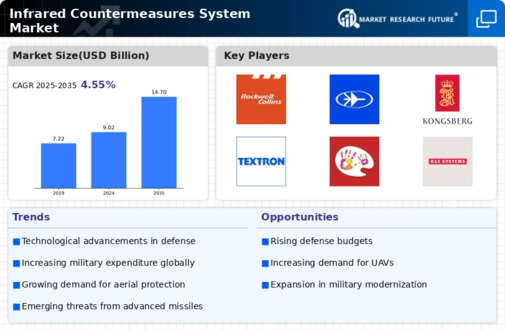Increased Defense Budgets
The Infrared Countermeasures System Market is benefitting from the rising defense budgets across various nations. Governments are prioritizing national security and investing heavily in advanced defense technologies, including infrared countermeasures. In recent years, several countries have reported increases in their defense spending, with some allocating over 2% of their GDP to military expenditures. This trend is particularly evident in regions facing heightened geopolitical tensions, where the need for effective countermeasures against aerial threats is paramount. As a result, the market is expected to witness a significant uptick in demand for infrared systems, as defense contractors strive to meet the requirements of modern warfare.
Expansion into Commercial Sectors
The Infrared Countermeasures System Market is not limited to military applications; it is also expanding into commercial sectors. Industries such as aviation, maritime, and transportation are increasingly recognizing the importance of infrared countermeasures for safety and security. For example, commercial airlines are exploring infrared systems to protect against potential missile threats during takeoff and landing. This diversification is likely to open new revenue streams for manufacturers and service providers, as the market adapts to meet the needs of various sectors. Analysts predict that the commercial segment could account for a substantial portion of the market share, further driving growth in the coming years.
Geopolitical Tensions and Regional Conflicts
The Infrared Countermeasures System Market is heavily influenced by ongoing geopolitical tensions and regional conflicts. As nations grapple with security challenges, the demand for advanced defense systems, including infrared countermeasures, is on the rise. Countries involved in territorial disputes or facing threats from hostile entities are increasingly investing in their military capabilities. This trend is particularly evident in regions with active conflicts, where the need for effective countermeasures against aerial threats is critical. As a result, the market is poised for growth, driven by the urgency to enhance national defense strategies and protect airspace from potential aggressors.
Rising Threats from Unmanned Aerial Vehicles
The Infrared Countermeasures System Market is significantly influenced by the rising threats posed by unmanned aerial vehicles (UAVs). As the use of drones in both military and civilian contexts increases, the potential for hostile actions using these platforms has become a pressing concern. This has led to a heightened demand for effective countermeasures that can neutralize UAV threats. Defense organizations are actively seeking advanced infrared systems capable of detecting and intercepting drones, which are often equipped with sophisticated evasion technologies. Consequently, the market is expected to grow as stakeholders invest in developing and deploying innovative solutions to counteract these emerging threats.
Technological Advancements in Infrared Countermeasures
The Infrared Countermeasures System Market is experiencing a surge in technological advancements, which are pivotal in enhancing the effectiveness of these systems. Innovations such as improved sensor technologies, advanced algorithms for threat detection, and miniaturization of components are driving the market forward. For instance, the integration of artificial intelligence and machine learning into infrared systems allows for real-time data analysis and decision-making, significantly improving response times. As military and defense sectors increasingly adopt these cutting-edge technologies, the market is projected to grow at a compound annual growth rate of approximately 5.2% over the next five years. This trend indicates a robust demand for sophisticated infrared countermeasures that can adapt to evolving threats.

















Leave a Comment